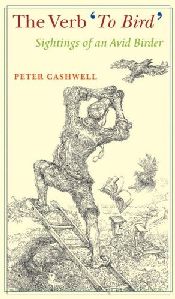Reviewed by Grant McCreary on December 20th, 2006.
As you read this book two things are immediately obvious about the author. The first is that he is an English teacher. Granted, he says this right on the first page. But this will become readily apparent when he quotes from Shelley, Keats and Tennyson while discussing birds in human culture. There are also numerous references to things other than poems like books and movies such as Lord of the Rings and Monty Python and the Holy Grail (think swallows).
The second is that he is not an expert birder. It takes some adjustment if you are used to reading the likes of Pete Dunne. Instead of reading about finding a rarity in some birding mecca, its an American Avocet in Delaware or a Great Horned Owl in South Carolina. Moreover, he is not infallible and often struggles with identifications. Even if that doesn’t sound very exciting to you Cashwell is an excellent writer and well able to keep your attention.
The book starts off with a definition and conjugation of the verb ‘to bird’ (more of the English teacher coming through). But that is limiting and doesn’t satisfy the author. From there he goes on to discuss birds in our culture, emphasizing religion and poetry. This first chapter isn’t entirely a literary discussion, thankfully. There is also a great section on Empidonax flycatchers and the honesty of birders. He warns that if “you see a list from a (birder’s) daily count with an unbroken string of ‘Alder Flycatcher, Willow Flycatcher, Least Flycatcher,’ etc., beware! He may not swipe the silverware, but you can bet that he’ll try to get you involved with Amway, or maybe put your name down to become part of his long-distance calling circle.”
The most difficult section to get through is the author’s quest to discover the root of the Cardinal’s name. It takes him all the way to the Library of Congress, but with no results. He does eventually find it, but not fast enough for the reader.
The book is at its best when Cashwell is actually birding. Thankfully that is most of the book. He details is growth as a birder – first simply being taken out on a birding trip, then taking along someone else on a trip, and finally making a pre-dawn trip to a popular site several hours away. Along the way are several detours to discuss topics such as the ravages of DDT and the plight of the Ivory-billed Woodpecker.
Perhaps the best is saved for the last chapter, “The Dickcissel Apocalypse”. It details the author’s birding romp in Iowa. There for a debate institute, a local birder took him out birding in response to a message left on the Iowa Ornithologists Union hotline. Speaking of which, there’s a great description of the hotline:
“Iowa Ornithologists hotline?” one friend cackled when I mentioned it. “What do you do, call it if there’s some sort of bird emergency? ‘Help, my wife’s being attacked by a bird! Send help!’ is that it?”
“That is a complete misunderstanding of the way birders’ minds work!” I retorted, bristling. “Of course you wouldn’t call a birders’ hotline to say that! You’d call to say, ‘Help, my wife’s being attacked by a bird and I’m not sure if it’s a Northern Shrike or a Loggerhead Shrike-what’s the difference?'”
The best encounter of that trip was an attention hungry Upland Sandpiper. It landed nearby while the author was trying to get a look at a possible life Sedge Wren. But the sandpiper would have none of that. It kept raising its wings and calling, demanding all the attention. While this may not sound very exciting, this passage cannot be done justice without repeating it word for word. The account is very funny.
The epilogue is where I most identified with the author. When he wrote it his life list was at about 250. As he says, “It seems I’ve reached a certain age, and now only certain birds are left: the rare, the out-of-the-way, and the very, very hard to find”. To add any more he realizes he is going to have to grow as a birder and do some traveling. When I read this I was approximately at the same place, so what he writes resonated with me. I can feel the same joy and excitement the author certainly felt after successfully hunting down a hooting Great Horned Owl at Christmas time. On the other hand, it feels odd reading a birding book by an author with significantly less experience than most bird book authors. That may be a larger obstacle for any readers who are more experienced.
This is definitely a worthwhile read. Just don’t go into it expecting to learn much about new birds or how to bird. That is not the aim of this book. Rather, it’s to express what it means ‘to bird’ and why one would want to. And it accomplishes this in a very humorous and well-written manner. However, it does not have much “replay value”. While I enjoyed it, I don’t foresee myself wanting to re-read it anytime soon.
Disclosure: I get a small commission for purchases made through links in this post.



Comment